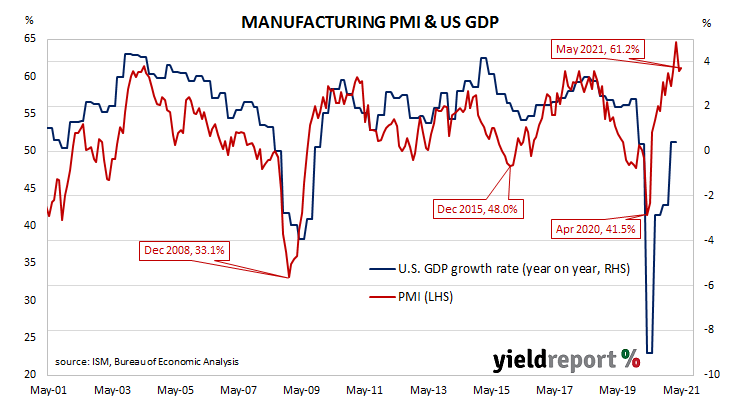Summary: ISM purchasing managers index (PMI) slightly up; above consensus expectation; US firms struggling with labour shortages, shipping delays, other disruptions; implies US economy still growing at rapid pace.
US purchasing managers’ index (PMI) readings reached a cyclical peak in September 2017. They then started a downtrend which ended in March 2020 with a contraction in US manufacturing which lasted until June 2020. Subsequent month’s readings implied growth had resumed before becoming stronger through the early months of 2021.
According to the latest Institute of Supply Management (ISM) survey, its Purchasing Managers Index recorded a reading of 61.2% in May. The result was slightly above the generally expected figure of 61.0% and slightly higher than April’s reading of 60.7%. The average reading since 1948 is 52.9% and any reading above 50% implies an expansion in the US manufacturing sector relative to the previous month.
“The data continue to show that as the US economy recovers, firms are struggling to keep up with surging demand due to labour shortages, shipping delays and other COVID-related disruptions,” said ANZ senior economist Catherine Birch.

NAB currency strategist Rodrigo Catril noted ISM’s employment gauge had fallen to a six-month low, “reflecting the difficulty in hiring and retaining labour, with the spokesman for the survey pointing to the enhanced unemployment benefits reducing labour supply…” He expects labour shortages to ease “in coming months” as US states withdraw the supplementary payments.
Purchasing managers’ indices (PMIs) are economic indicators derived from monthly surveys of executives in private-sector companies. They are diffusion indices, which means a reading of 50% represents no change from the previous period, while a reading under 50% implies respondents reported a deterioration on average. According to the ISM, a reading “above 42.8%, over a period of time, generally indicates an expansion of the overall economy.”

